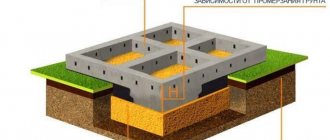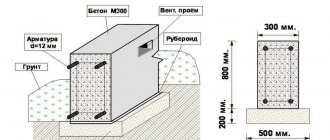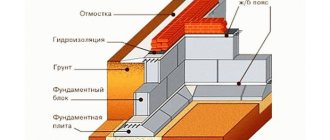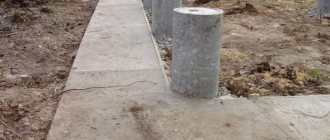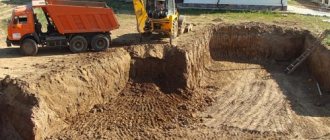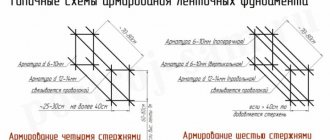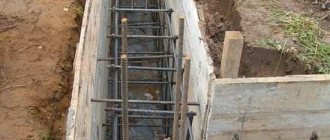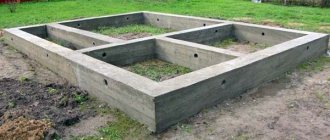Everything you need to know about strip foundations.
Experts in the construction industry classify the strip type of base as a monolithic base, but only with the exception of one, but very significant difference - cost-effectiveness and accessibility. Despite the fact that the amount of concrete solution required for the work is reduced, the foundation does not lose its strength characteristics and is particularly reliable. Today it is used for the construction of high-rise buildings, industrial and public facilities, and also, of course, in the construction of country cottages of any number of floors.
Monolithic foundation plan drawing.
Monolithic foundations of various types
For the construction of wooden houses, a monolithic foundation is best suited, which is ideal for the construction of buildings of almost any configuration.
Among monolithic bases, several types can be distinguished.
A monolithic strip foundation is a strip made of reinforced concrete that runs along the entire perimeter of the house. Used in the construction of brick buildings, houses with basements or garages, and wooden buildings.
Laying drawing of a strip monolithic foundation for a house
A columnar monolithic foundation is a set of pillars installed in places of increased load. Between the pillars it is planned to fill with sand or crushed stone and then fill with concrete. Such foundations are often used in the construction of light houses.
Scheme for laying a columnar monolithic foundation
A solid monolithic foundation is used in conditions of highly compressed soil and is laid under the entire area of the house.
These types of foundations are used, in most cases, in the construction of light wooden houses. Their main advantage is the absence of restrictions on the configuration of the building, as well as the need to use expensive equipment. The cost of constructing a monolithic foundation takes up about 15-20% of the total cost of the house.
Supports for strip base.
Support structures that are used for this type of foundation come in 2 varieties, namely:
- Strip monolithic foundation. The concrete mixture is gradually and evenly poured into the pit;
- Prefabricated strip foundation. In addition to the mortar, ready-made reinforced concrete structures are also used.
Prefabricated strip foundation plan drawing.
Drawing with additional drawings (large scale).
In order to determine how deep the trench should be in this case, it is necessary to be guided by a soil freezing map. It is different for each area, and if an inaccurate indicator is used during work, then such an oversight can be fraught with shrinkage of the structure or even destruction of the entire foundation. The width of the pit depends on the load that will be placed on the foundation during the direct operation of the house.
What are prefabricated foundations?
A prefabricated foundation is a foundation that is constructed from individual structural elements produced on an industrial scale. Such products include:
- Foundation pillows. This part of the base is one of the most significant. Since it is from this that the load is transferred - from the structure to the ground. In terms of its appearance and design features, this product is a reinforced concrete slab, which has a trapezoidal cross-section. You can find foundation pillows in a variety of sizes. Considering that the pillow plays a very important role in the design of the building, increased demands are placed on the manufacture of this element; for example, the pillow is made using a durable reinforcement frame.
- Foundation blocks. In the construction industry, this product is often referred to as FBS. The appearance of the foundation block is an elongated parallelepiped, which is also made of reinforced concrete. At the ends of the block there is a place for filling its liquids during installation. Reinforced concrete block can have different sizes.
Prefabricated reinforced concrete foundation is most often used in construction because it has several advantages:
- It is much faster to erect the foundation of a building thanks to the use of ready-made products in this process. After the foundation is assembled, you can almost immediately begin to erect the walls of the structure, which is impossible to do when arranging monolithic foundations.
- Prefabricated foundation strips are of high quality, since they are constructed from ready-made parts, the quality of which is confirmed by the GOST standard. Such products are produced at industrial-scale enterprises where quality control is carried out quite strictly.
However, despite its great popularity, it is still necessary to take into account some of the disadvantages inherent in reinforced concrete products and prefabricated foundations in general:
- Prefabricated strip foundations are less durable than monolithic foundations.
- Prefabricated strip foundations include seams that remain between the products. Due to this feature, ensuring thermal insulation, as well as protecting the building from moisture, is much more difficult than when installing a monolithic foundation.
- Sometimes the arrangement of prefabricated strip structures is more expensive for builders, since the delivery of products to the construction site requires quite large expenses. In addition, when installing a prefabricated strip foundation, the services of a crane may be required to place heavy structures in the right places. Therefore, experts recommend carrying out calculations at the stage when a drawing of the building is drawn up and the type of foundation is selected.
Today in construction practice, variants of a combined foundation have become widespread, when the base of the structure itself is made in the form of a monolith, and the walls in the form of a prefabricated strip foundation. You can see this option for constructing a support in more detail in the photo. It should be noted that the combination of a monolith with a prefabricated strip structure is more durable than the use of conventional prefabricated strip foundations.
What should be taken into account during calculations?
In order to carry out calculations correctly, it is important to consider the following characteristics:
- the weight of the future structure. To calculate this indicator, you should be guided by the total weight of the materials that will be used for construction. An important factor is the number of storeys of the structure.
- soil type. It has a direct impact on the degree of shrinkage.
- the degree of load on the foundation during the period of operation.
Foundation plan drawing.
We make the plan correctly.
When creating supports for a strip foundation, the drawing must meet the following requirements.
- When determining the most appropriate scale, it is highly recommended to choose either 1 in 100 or 1 in 400.
- Before starting construction work, the site should be marked.
- If you plan to create a house or public structure with columns, be sure to indicate this designation and section on the drawing.
- All lines on the paper must be clear and precise, the thickness of each of them is 0.5-0.8 millimeters.
In the general diagram there must certainly be a designation of the sole, as well as the places in which various bulges or depressions will be located. This is important in order to calculate the location of communications from central highways.
Plan of a strip foundation made of FBS blocks drawing.
Such holes and protrusions must be displayed on the diagram as contours and broken lines. Explanatory notes and footnotes may be provided if necessary.
Reinforcement planning
Unfortunately, a strip foundation is a vulnerable structure: its strength depends on:
- Compliance with the conditions of the area in which construction is taking place and the parameters of the foundation.
- Correct load calculation.
- Built-in strength reserve.
Reinforcement is used to strengthen the strip foundation. Reinforcing rods are used for this purpose. When drawing up a plan, a reinforcement scheme for the concrete strip is also created: the diameter of the reinforcing material is selected, its placement in space and the required quantity are determined.
To create a reinforced frame, hot-rolled products are usually used, with the help of which pre-stressed and conventional structures are strengthened. Reinforcement is selected for specific types of buildings according to its strength class, which ranges from A1 to A4 and depends on the type of steel used in production. Thus, for the manufacture of products of classes 1 and 2, low-carbon steel is used, for 3-4 - alloyed steel. This allows you to create the most suitable reinforced frame in terms of strength characteristics for a specific structure, taking into account its operational characteristics. If the height of the base is higher than 1.3 m, it will be necessary to carry out transverse reinforcement, which is also drawn in the plan.
The basis of the classical reinforcement scheme is a rectangle reinforced at the bottom and top and longitudinal reinforcement connected by vertical and transverse reinforcement. All this together creates a box, which gives strength to the foundation frame. The number of tiers depends on the height to which the monolithic strip foundation should rise. The layout of the reinforcement must be shown in the project. In addition, it contains a strip foundation plan and a drawing of the placement of the reinforcing box, taking into account the necessary clearances between the formwork and the reinforcement.
Difficult sections of the diagram.
If you are planning to build a capital and large-scale structure, then it will most likely require the creation of a complex prefabricated or monolithic foundation. As a rule, such diagrams cannot be contained in one drawing. Therefore, experts in the construction industry strongly recommend developing separate plans for complex areas. Alternatively, you can apply additional centerlines and section designations (if necessary) to the main plan, as well as create large sections on the sheet, having previously made a mark about this. In addition, depending on the degree of section, it is recommended to choose a scale of 1 to 20, 1 to 25, or 1 to 50, in order to get the section and complex structural elements as close as possible.
Strip foundation plan drawing.
Characteristics
Depending on the material used, the service life can be:
Types: a) block, b) monolithic, c) brick, d) on heaving soils.
- monolithic and rubble concrete with cement mortar - up to 150 years;
- prefabricated concrete – 50-75 years;
- brick strips – 30-50 years.
According to their design features, strip bases can be:
- Monolithic, carried out directly on the construction site.
- Prefabricated, made from standard reinforced concrete blocks, which are produced at the factory and installed on the construction site using a crane. Prefabricated buildings are made from reinforced concrete slabs - concrete blocks and pillows.
Depending on the magnitude of the load, we can distinguish between deep and shallow. A recessed and shallow monolithic strip foundation is a rigid horizontal reinforced concrete frame that runs completely along the entire perimeter of the building. This can ensure the stability of the house under conditions of heaving and slightly heaving soils. In this case, a rational ratio of “cost-effectiveness – strength” can be achieved. In this type, budget costs will be only 15-18% of the total cost of the entire construction.
Shallow ones are built for light houses and baths or on slightly heaving soils.
Shallow-depth may be well suited for light houses (foam concrete, wood, small brick, frame). A similar structure is installed on slightly heaving soils. The depth at which it is laid is 50-70 centimeters.
A recessed strip structure is built in houses with heavy floors and walls and most often on heaving soils. Such a device is necessary if you plan to install a garage or basement in the house. The depth of such a structure is most often 20-30 centimeters lower than the freezing depth of the soil. Such a device requires the consumption of more material. Under the walls that are located inside the building, it is possible to make a shallower foundation, 40-60 centimeters.
Compared to shallow-depth, buried is more stable and durable, due to the fact that its bottom is below the freezing level of groundwater, in addition, it is not subject to deformation. However, material consumption and labor intensity increase.
Reinforcement is made for greater strength.
These devices, as a rule, should be installed exclusively in the warm season. There is no need to use any expensive equipment. Small mechanization and a concrete mixer will be enough.
On sandy or dry soils, the strip structure can be laid higher than the freezing depth, but not less than 50-60 centimeters from ground level.
On deeply frozen and highly swelling soils, strip foundations are used quite rarely.
Such structures are widely used in civil and industrial construction, as well as in the construction of individual residential buildings and cottages.
Additions to the scheme.
If you are going to create a monolithic or prefabricated type of strip base, then, to clarify the drawings, you should accompany them with the following technical documents:
- Scheme of reinforcement of the site based on the future load of the structure on the foundation;
- An application that displays the design features of a structure;
- Advisory explanations regarding preparatory work on the site;
- Tables and diagrams that are necessary for waterproofing and thermal insulation of foundations.
- Data on load standards on foundation supports.
Strip foundation plan drawing.
Additional parameters of the strip foundation plan
The calculation of a column-strip foundation is not complete without a table that indicates the load standards for this type of structure. This number also includes metal or concrete elements that will be located below floor level.
Attention: the most significant parameter is the safety margin, which must be taken into account at this stage. If it is not enough, reinforce the concrete with additional reinforcement.
The finished plan is verified in AutoCAD. This is the name of a program that allows you to see an image in 2D or 3D. Moreover, the entire amount of work is performed by the computer after dynamically entering the parameters of the future design.
Determination of the degree of depth.
As already mentioned, the depth of the trench to create a strip-type foundation is calculated depending on the scope of application of the supports. Today, two main types of structures are popular – deep and shallow. Once you decide which option is worth giving preference, the corresponding designation should be made on the plan.
- The first type of base is characterized by reinforced reinforcement and is an excellent choice for large structures, the design of which involves the creation of basements, attics or heavy partitions. It is believed that the most optimal indicator of the degree of deepening of a trench for a tape is an indicator that is 20-25 meters higher than the level of soil freezing depth in a particular region.
- The drawings certainly contain information about how deep the tape will be buried. It is important to remember that the amount of consumables for forming buried supports is an order of magnitude greater.
Strip foundation reinforcement plan drawing.
Additional drawing (complex reinforcement).
Calculation by depth and width
To determine the basic parameters, you should clarify the characteristics of the soil composition and the size of the facility under construction. If you are planning a two-story house made of brick material, the foundation should be buried below the freezing level of the soil to sixty centimeters. In this case, on soft soil, the total depth of the foundation can be from two to three meters.
If the building is not too heavy, then the foundation is allowed to be buried half a meter. With homogeneous and strong soil, the laying depth is made even smaller - about forty-five centimeters.
When drawing up a project, you should take into account the layout, dimensions, width of the external and internal walls, for the construction of which the foundation is laid. As a rule, the minimum width of the foundation strip is assumed to be equal to or greater than the corresponding wall size. It is allowed to overhang the walls from the foundation up to thirteen centimeters. The fact is that the strength of the foundation allows it to withstand the load created by the walls, and the difference in size allows you to reduce the cost of reinforcement and pouring concrete.
Based on the dimensions of the sole, the entire width of the load-bearing walls is calculated by adding the loads on the foundation, which transfers them to the soil.
It is necessary to have geological exploration data that provides a complete description of the properties, level of freezing, and depth of groundwater.
Data on freezing depth for a particular region can be clarified in special construction reference books. If there is a possibility of changes in soil heaving and changes in water depth, it is recommended to order special studies of the soil area, which will help avoid unreasonable costs associated with identifying undesirable soil properties.
In each case, a layer of sand or gravel with a height of ten to twenty centimeters should be placed under the foundation, so when digging a trench you will have to take this additional depth into account.
The dimensions of the foundation base are determined so that the loads created do not exceed the permissible weight on the soil at the work site.
If the structure under construction has square or rectangular shapes, then their parameters are calculated quite easily. In the case when it is necessary to pour a complex foundation structure, a division is made into main structural elements, the volumetric and dimensional parameters of which are then added up.
Having determined the height and width of the foundation, it remains to calculate the amount of concrete mixture, reinforcing bars, and material for formwork panels.
Fundamental differences in support schemes.
Above, we tried to describe in as much detail as possible the process of creating a structure plan for which a strip foundation drawing is used. But at the same time, we should not forget that the drawings containing information about the prefabricated type of supports are fundamentally different from monolithic ones in that they contain a section, as well as a designation of straight and angular reinforced concrete structures.
Strip foundation plan drawing.
We carry out the calculations ourselves.
We assure you that today there is a sufficient amount of information available on the Internet in order to carry out all the necessary calculations as much as possible. To do this, it is absolutely not necessary to be an engineer or have a technical education. With a responsible approach to the issue, as well as being an observant and attentive person, you can easily calculate all the criteria necessary to create, for example, a strip foundation for a non-residential structure or a building envelope. It is important to consider the following:
- Vertical impact on the ground;
- The weight load of the main structure on the base;
- The weight of the roof and rafter system (but only if you are going to build a barn or non-residential outbuilding);
- When creating a foundation drawing, in order to eliminate errors, the results must be multiplied by “2%”. This will help protect against possible shortcomings during the independent design process.
Strip foundation plan drawing.
Positive and negative sides
The positive aspects of using these devices include a reduction in construction time and the ability to load structures after a short period of time after installation.
In order to fill the structure, it is necessary to build formwork.
It should be borne in mind that such a device may be more expensive than monolithic ones. In addition, it requires the use of lifting equipment and workers who have a high level of qualifications.
It is worth understanding that there are also negative sides. These include: the strength indicators of a prefabricated structure (with the same thickness) are 20-30% lower than those of a monolithic one. A foundation made from prefabricated blocks does not have the same rigidity as a monolithic one, because it consists of individual elements. The prefabricated device cannot be strengthened with additional fittings. This is due to the fact that the blocks are produced according to one standard design.
Reinforcement can be achieved using meshes that are laid between rows of blocks, however, this will not give the same result as spatial reinforcement of a monolithic structure.
The base is reinforced and filled with concrete.
You can reduce the material costs of a structure of this type for a building with a small number of floors by laying blocks of walls and pillows in a continuous row. It is necessary to make a small run (foundations, which are called intermittent). Intermittent devices make it possible to save up to 20-25% of blocks. This will affect construction costs.
It should be remembered that if the existing site has silt, peat and soils with weak bearing capacity, discontinuous foundations will be unacceptable.
It is worth noting that the strip structure made from prefabricated concrete blocks is inferior in strength and other performance characteristics to its relative - a monolithic device.
Will the services of professional specialists be required to create the drawing?
Of course, a plan for a strip foundation for a residential building requires much more accurate and detailed calculations, which are best left to a specialist. When contacting a master of his craft, you can be sure that the drawing will:
- easy to read;
- as accurate as possible;
- meeting all SNiP requirements;
- containing comprehensive information about the preparatory work;
- having, in addition to the main drawing, technical applications in the form of various tables, diagrams, etc.
Strip foundation formwork plan drawing.
In this article, we tried to provide comprehensive information about the process and principle of creating a drawing of a strip foundation for residential as well as non-residential structures.
And remember that if you are not confident in your abilities, then do not try to carry out the calculations necessary for such a basis on your own or using unlicensed programs. Saving in this case can be fraught with huge losses or even the destruction of the entire building or fence.
Why do you need a plan?
The foundation plan is the main one in the list of construction documentation, and it must indicate those linear characteristics on which the following factors depend:
- the weight for which this foundation is designed (depends on the materials used for construction, the number of floors, internal layout, purpose of the building, etc.);
- design features (with or without a basement, subfloor, cellar, with or without the possibility of creating a basement floor).
If the strip foundation diagram is created with errors or major errors, this can lead to a variety of consequences: from the inability to complete the required implementation of the house project as it was intended, to destructive processes in the foundation and, as a consequence, in the entire building structure.
How to make a foundation drawing?
At the initial stage, it is necessary to determine the dimensions of the building, obtaining the four axes of the external walls. Then the axes of internal load-bearing walls and heavy partitions are added to the project, taking into account the following factors:
- enclosing structures must withstand the weight of cladding, ceilings, rafter system, roofing
- When choosing a wall material that needs protection from getting wet and solar ultraviolet cladding, it is more rational to use a ventilated façade with insulation inside it.
- then all loads on the foundation and the soil underneath are collected (the weight of structural, cladding materials of the roof, ceilings, walls, wind and snow loads)
- after which, you can calculate the width of the sole
Then on the sketch it is enough to add two lines (inside, outside the perimeter) from the axes of the strip foundation. The formwork panels will be mounted along these cords; the string along the axial lines will make it possible to control deviations in the geometry of the monolithic foundation.
Plan of a monolithic strip foundation drawing.
The simplest design method.
When calculating individual elements of a strip foundation , tables SP 22.13330 or V. S. Sazhin’s Guide will be required. The technology for calculating the width of the tape is as follows:
- prefabricated load calculation
- soil determination visually or by rolling into a rope
- dividing the resulting figure by the calculated soil resistance taken from the tables for specific soil on the site (minimum value to compensate for possible errors)
Strip foundation plan drawing.
The burial depth for MZLF is 0.3 – 1 m depending on the groundwater level. Recessed strips are lowered below the freezing mark by 0.4 - 0.6 m. The height of the basement part of the foundation depends on the preferences of the developer:
- by pouring the tape at 10 - 20 cm from the ground level, you can create a floor on the ground, sharply reducing the construction budget
- when lifting by 40 - 60 cm, a ceiling on beams or a slab is used; ventilation vents are required in the basement
- if an underground floor is planned, the height of the basement depends on the level of the finished floor in it
Based on the calculation results, it is possible to prepare a drawing for moving the axes to the building site and carrying out excavation work.
Sketch of a strip foundation.
To accurately draw a monolithic foundation, you need access to professional graphic editors AutoCAD, Compass, Solid Work, Archikad. Therefore, paper sketches are often used for garden buildings. On it it is necessary to mark the axes of the walls, auxiliary structures (stove, internal staircase, porch, fireplace), and draw the contours of the foundation strip.
Reinforcement scheme.
Foundation plan drawing how to draw.
For any strip foundation, reinforcement is necessary if it is planned to manufacture a monolithic structure on site. The layout of the lower and upper reinforcement frame can be depicted in the same drawing. You will need it to draw up estimates when purchasing rods, wire, spacers, and stands. When drawing a diagram, you must consider:
- It is prohibited to overlap the rods in the corners; the reinforcement is bent at right angles and overlapped on the adjacent side of the tape
- when extending rods along the length, the overlap should be 60 - 70 cm
- in wall joints, the rods are joined similarly to the corners (bending, launching to the adjacent side)
- the protective layer (distance from the concrete surface to the reinforcement) is 1.5 – 4 cm
Strip foundation reinforcement plan drawing.
When the belt width is less than 15 cm, one rod in each belt is sufficient. In wide tapes, the minimum distance between the rods (in the clear) should be more than 35 mm (bottom), 40 mm (top). Reinforcement is needed in the lower part at the sole, near the upper edge of the structure. In the middle part, the tape is reinforced only when it is high (from 0.7 m).
Methodology for arranging the foundation
All work consists of several successive stages. If you violate the technology described, you will not be able to achieve full compliance with quality and GOST. For this reason, we involve the best specialists in this work who understand all the nuances of foundation construction.
Rice. 1.4 : the diagram shows an example illustrating a strip-monolithic foundation, manufactured in accordance with all GOST requirements.
So, the process of work from specialists goes like this:
- Geological surveys. This is done primarily to determine the nature of the soil, for example, swampiness, degree of freezing, etc. In this process, the climatic conditions of a particular region of the country are taken into account.
- Marking. Having marked the corner of the future foundation, two perpendicular lines are laid from it. The width of the base should not be less than 400 mm. This is also determined at the marking stage.
- The base is being worn out. Worn-down is required in order to fix the marking points at a distance of two meters from the house. The cast-off is made of wood.
- Complete removal of the fertile soil layer. As a rule, this is a depth of up to 200 mm. Next, the trench is dug strictly according to the markings. If the soil is crumbly, then the walls of the trench are additionally strengthened.
- Laying a sand cushion up to 200 mm thick. First, gravel is poured onto the bottom, and then sand. This mixture is thoroughly compacted.
Expert advice! Before pouring the foundation, we manufacture a drainage system. This will prevent flooding of the entire structure.
- Next, the formwork is made from wooden panels.
- A reinforced belt is placed inside the formwork.
- Additionally, holes are made for laying utility lines.
After all the preparatory work, our specialists fill the monolithic strip foundation. When the concrete has acquired its strength, waterproofing and thermal insulation work is carried out.
Construction technology.
For a monolithic foundation, a standard construction methodology is used, consisting of the following stages:
- full-scale axle offset
- trench/pit excavation
- filling the foundation cushion
- sole waterproofing
- installation of formwork
- reinforcement
- concreting
- surface waterproofing
To reduce heaving forces, the blind area and the side surface of the tape are insulated, and drains are laid at the level of its sole. At each stage there are nuances that make it possible to reduce the amount of work and increase the service life of the structure.
Marking, pit.
Before moving the axes into the construction site, it is necessary to place the building on the site for normal operation of engineering systems, fertile soil, and the dwelling itself. For example, there is often parking on the street side; an external sewage septic tank requires periodic emptying, so it is also located closer to the street. It must be at least 4 m away from the foundation to ensure a sanitary zone.
Strip foundation plan drawing.
Power transmission poles and wells with shut-off valves for connection to central life support systems are also installed here. The front facade is most often turned towards the roadway. After this, it is enough to mark the strip foundation according to the scheme:
- first wall – starting corner 3 m from the boundaries of the site, spine 5 m from the red line (street road)
- side walls - perpendicular to the first axis (construction of a triangle with 4.3 m legs, 5 m hypotenuse)
The corners of the last wall (the rear facade of the house) are obtained automatically. During excavation work and the manufacture of the foundation pad, the cord must be periodically removed. To avoid repeated measurements, castoffs are recommended - a horizontal block between two pegs. You need 2 of them for each axis; three strings can be pulled across wide slats at once (the side edges of the foundation, the axis of the wall).
Cushion, formwork.
The layer of non-metallic material under the bottom of the monolithic foundation is intended to replace heaving material and level the bottom of the trench. The most popular underlying scheme is:
- sand 20 cm + crushed stone 20 cm – laid on geotextiles, wrapped with it on top after compacting every 10 cm
- crushed stone + sand (the thickness is similar) is a more convenient option; an extra layer of geotextile is added between these materials, but there is no need to fill the footing when laying roll waterproofing
- sand 40 cm or crushed stone 40 cm - the first option only for low groundwater levels, the second for high groundwater
Rolled waterproofing (usually hydroglass insulation) is laid in 2 - 3 layers with a release so that after concreting it can be rolled onto the side edges of the tape. The formwork is mounted on top of it; it is better to use materials that can be reused (OSB, plywood, edged boards).
Vertical panels, the height of which is 5 cm greater than the design mark, are supported against the sides of the trench, the ground, and fastened with jumpers (pins, bars). In the underground level it is necessary to leave openings for the introduction of engineering systems, in the basement part of the ventilation duct. To do this, pipes are passed through the shields, which remain in the concrete for sleeves or are pulled out when stripping.
Strip foundation formwork plan drawing.
Reinforcement, filling.
The aromatic frame of a strip foundation is usually two-level. For light buildings, two corrugated rods in the upper chord and two in the lower are sufficient. To fix the rods inside the formwork, rectangular clamps are used, curved from smooth 6-8 mm reinforcement, to which longitudinal reinforcement is tied with wire. The main requirements are:
- spacing of joints in adjacent rows by 60 cm minimum
- bend at the corners
- overlap from 60 cm
Strip foundation reinforcement plan drawing.
The bottom bars rest on polyethylene supports or concrete pads to provide a protective layer. pouring occurs according to standard technology with compaction along a ring of every 60 cm of concrete to remove air.
Waterproofing, drainage.
For a monolithic foundation . partially or completely immersed in the ground, protection from moisture is necessary. This is done in several ways:
Strip foundation waterproofing plan drawing.
- waterproofing the outer edges of the tape - penetrating products, coating with bitumen mastic, gluing with Gidrostekloizol or the last two options in combination
- drainage system – placed around the perimeter at the level of the tape sole
Foundation pit plan drawing.
A storm drain (storm inlets + surface gutters) is built into the outer perimeter of the blind area, with the help of which melted rainwater is drained.
The above technology is suitable for strip foundations of any type, deepening. Recommendations from experts will help avoid mistakes and reduce the labor intensity of construction operations. The housing will have a high service life, despite independent calculations.
Choosing a foundation type
I wrote about foundations in other articles, so I won’t dwell on the types of foundations, I’ll refer you to the “Foundations” section. I have a choice between slab and tape.
The advantage of a slab foundation is that it is simpler and clearer to make. But there is a large consumption of reinforcement and a problem with the height difference from the highest point to the lowest point of 66 cm. It turns out to be quite an expensive pleasure to pour such a prism with a seal. Moreover, you need retaining walls and terracing of the site (dividing into terraces with retaining walls). Considering that the layer of stones is 35-40 cm, this work will be very difficult and expensive. Therefore, we will have to abandon this type of foundation.
The tape also has advantages due to the great “fool resistance” of such a foundation. And rocky soils forgive many mistakes of builders. And such soils are not heaving and are not subject to frost heaving. The depth of placement does not depend on the depth of freezing. But since the foundation is on a slope, I want to go 60 centimeters deep. Considering that the foundation should lie in the same plane whenever possible, I will have to make ledges at the bottom to save on earthworks and concrete.
Building a shallow or shallow foundation is also not an option - the drop is too large and the base is too high. Alas, we will have to abandon this type of foundation.
So, from 3 options I choose the tape.
General information.
The foundation in the concept of construction is the underground part of the building (structure), which receives loads and transfers them to the base. If you look at the drawing of a monolithic base, you can highlight the following parts. The base is layers of dense soil. The upper plane on which the above-ground parts of a structure or building are located is called the edge or surface. Its lower plane, which is in direct contact with the base, is called the sole.
Residential building foundation plan drawing.
The tape is laid around the perimeter of the building.
A strip foundation is a strip of reinforced concrete that runs along the perimeter of the entire building. The tape is laid under all external and internal walls of the building. The construction technology is quite simple compared to pile or slab construction. To build a strip foundation, a drawing is required. Such a foundation is labor-intensive and requires a considerable consumption of materials compared, for example, with a columnar type (more concrete, formwork; you will definitely need to use a crane).
Tape can be used:
Strip foundation plan drawing.
Strip foundation diagram
- In houses with concrete, brick and stone walls (the density of which is more than 1000-1300 kg/cub.m).
- For houses with heavy floors (precast reinforced concrete or monolithic, metal).
- If there is a threat of uneven precipitation due to heterogeneity of soils on the site (for example, the site in one part is composed of sands, and in the other - heaving loams). A reinforced strip base can work as a single whole, redistribute forces, and then the walls of the house will not cause deformation or cracks.
- If you plan to have a ground floor or basement in the house and the walls of a similar strip structure will form the wall of the basement.
In the process of planning the construction of a house, it is quite important to competently and responsibly approach the choice of the type of structure being manufactured, because this element is one of the most important structural elements for construction. An error at the beginning of construction, saving building material, an incorrectly designed structure, or an incorrect drawing will lead to serious negative consequences during the operation of the house.
Strip foundation plan, section drawing.
Structures: a, b) prefabricated, c) monolithic, d) rubble.
Problems may arise such as distortions, excessive consumption of materials, horizontal and vertical deformations, uneven settlements, cracks in supporting structures, and so on. To a great extent, a large number of qualities of the building will depend on reliability, in addition to its durability and capitality.
It should be remembered that the zero cycle of building a building is a somewhat expensive process, and most often it accounts for a third of the cost of the entire building. It is best to order a project and drawing from experienced designers. It is worth understanding that you can ask them only if you draw up the contract correctly. The organization in the project can reasonably and competently choose the type and material with which the foundation can be made.
Strip foundation plan: features of documentation production
The foundation is the lower part of buildings. It takes on all the loads, transferring them further into the layers of dense soil. There are several types of foundations, among which strip foundations are considered the most durable. This is a reinforced concrete strip laid around the perimeter and under the internal walls of the entire structure. But for a structure to fulfill its purpose, it must be built correctly. That is why the main element of preparation for work is the strip foundation diagram. Do you need a plan? Among all construction documentation, the main place is occupied by the foundation design diagram. This document specifies characteristics that depend on factors such as:
- The weight of the designed building under which the foundation will be erected. This indicator depends on the number of storeys of the future structure, its purpose, internal layout, materials used for construction, and others.
- Design features. We are talking about the presence of an underground floor, a ground floor, or the absence of them if the building does not have a basement or other features.
If the design of a strip foundation is carried out incorrectly with errors or errors, the consequences can be serious - from the inability to build the structure to the destruction of the foundation, which will entail the destruction of the entire structure.
